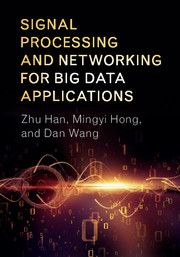Book contents
- Frontmatter
- Dedication
- Contents
- Part I Overview of Big Data Applications page
- Part II Methodology and Mathematical Background
- Part III Big Data Applications
- 8 Compressive Sensing-Based Big Data Analysis
- 9 Distributed Large-Scale Optimization
- 10 Optimization of Finite Sums
- 11 Big Data Optimization for Communication Networks
- 12 Big Data Optimization for Smart Grid Systems
- 13 Processing Large Data Sets in MapReduce
- 14 Massive Data Collection Using Wireless Sensor Networks
- Bibliography
- Index
14 - Massive Data Collection Using Wireless Sensor Networks
from Part III - Big Data Applications
Published online by Cambridge University Press: 18 May 2017
- Frontmatter
- Dedication
- Contents
- Part I Overview of Big Data Applications page
- Part II Methodology and Mathematical Background
- Part III Big Data Applications
- 8 Compressive Sensing-Based Big Data Analysis
- 9 Distributed Large-Scale Optimization
- 10 Optimization of Finite Sums
- 11 Big Data Optimization for Communication Networks
- 12 Big Data Optimization for Smart Grid Systems
- 13 Processing Large Data Sets in MapReduce
- 14 Massive Data Collection Using Wireless Sensor Networks
- Bibliography
- Index
Summary
Introduction
Wireless sensor networks provide a model in which sensors are deployed in large numbers where traditional wired or wireless networks are not available/appropriate. Their intended uses include terrain monitoring, surveillance, and discovery [644] with applications to geological tasks such as tsunami and earthquake detection, military surveillance, search and rescue operations, building safety surveillance (e.g., for fire detection), and biological systems.
The major difference between sensor networks and traditional networks is that unlike a host computer or a router, a sensor is typically a tightly constrained device. Sensors not only lack long life spans due to their limited battery power, but also possess little computational power and memory storage [645]. As a result of the limited capabilities of individual sensors, one sensor usually can only collect a small amount of data from its environment and carry out a small number of computations. Therefore, a single sensor is generally expected to work in cooperation with other sensors in the network. As a result of this unique structure, a sensor network is typically data-centric and query-based [646]. When a query is made, the network is expected to distribute the query, gather values from individual sensors, and compute a final value. This final value typically represents key properties of the area where the network is deployed; examples of such values are MAXIMUM, MINIMUM, QUANTILE, AVERAGE, and SUM [647, 648] over the individual parameters of the sensors, such as temperature, air or water composition, and so on. As an example, consider a sensor network monitoring the average vibration level around a volcano. Each sensor lying in the crater area submits its own value representing the level of activity in a small area around it. Then the data values are relayed through the network; in this process, they are aggregated so that fewer messages need to be sent. Ultimately, the base station obtains the aggregated information about the area being monitored.
In addition to their distributed nature, most sensor networks are highly redundant to compensate for the low reliability of the sensors and environmental conditions. Since the data from a sensor network is the aggregation of data from individual sensors, the number of sensors in a network has a direct influence on the delay incurred in answering a query.
- Type
- Chapter
- Information
- Signal Processing and Networking for Big Data Applications , pp. 301 - 321Publisher: Cambridge University PressPrint publication year: 2017



